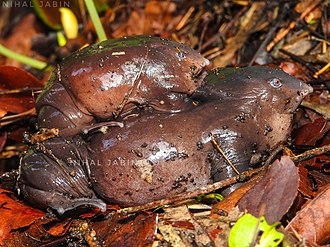India bears one of the most unique amphibian megafauna in the world despite not being recognised as such on a global scale. About 156 new endemic amphibian species have been discovered in India since 2000, with an average of 10 new species every year. The count and conservation of these endemic species weren’t taken too seriously until recently when the Western Ghats was labelled as one of the ‘hottest biodiversity hotspots’ in the world and the focus shifted from phylogeny and taxonomy to conservation and ecology. The Western Ghats is home to one of the richest biodiversity in the world, having species that cannot be found anywhere else and yet several of these species are on the brink of extinction.
The Purple Frog
One such species is the rare Purple frog. The purple frog or the pig-nosed frog is an unusual frog, native to the Southern Western Ghats (Kerala and Tamil Nadu), having a deep pink to dark greyish-purple colouration on its body. Scientifically named after its strange nose (‘naasika’= nose in Sanskrit) and the name for the Western Ghats (Sahyadris), Nasikabatrachus sahyadrensis is one of the only two species (the other being Nasikabatrachus bhupati) present in the family Nasikabatrachidae. It is dubbed as a ‘once in a century find’ by bio- geographers around the world.
This indigenous frog was described several times by the people of Kerala, including its tadpole in 1918, however the credits to the official discovery of this frog has been given to SD Biju (Tropical Botanic Garden and Research Institute, Pallode, Kerala) and Franky Bossuyt (Vrije Universiteit Brussel), who found it in the Idukki district of Kerala and introduced it to the scientific circles. It had escaped the notice of most biogeographers since it preferred staying underground for most of its life (except for the 2 weeks during pre-monsoon season when it comes out to mate). It prefers damp, moist, loose, aerated soil that is close to a waterbody, for the female to lay its eggs.
Molecular evidence suggests that its closest relative is the Sooglossids- in the Seychelles Island in Africa which implies that the frog existed before the continental drift and hence supporting the idea of the Gondwanaland Supercontinent. It is believed to have existed for 120 million years, evolving independently without much divergence from its ancestors, thus earning its place as a living fossil of all living frogs.

“Mahabali”
Being one of the rarest frog species to be endemic to Kerala and the increasing need to conserve it, the state government has made it a contender for the title of the State Amphibian of Kerala, calling it the ‘Māveli (Mahabali) Frog’, owing to its rounded body form and its once in a year appearance. According to the indigenous people of Idukki, it ‘resembles a turtle without a shell’ and
Being a fossorial form, it has a strongly ossified skull, well calcified bones and hind feet possessing large shovel-like inner metatarsal tubercles for digging. It can dig into loose soil within 3-5 minutes and escapes into gravel surfaces using stretching movements. It moves about under the soil at night though it never emerges. During April to May, the male lets out a mating call of 5-6 pulses at 1200 Hz, from inside its burrow. The loose damp soil helps propagate this sound. This puts the frog in a vulnerable position as it reveals itself to predators like brown fish owls, checkered keelbacks and fishing spiders, and consumes a lot of its energy. The larger female carries the male on its back to lay 3600 eggs in the crevices of a stream-bed. The male pushes the eggs out of the female using its hindlimbs and fertilizes them. The unique habitat and timing reduces chances of predation and competition. The wide, flattened tadpoles have a wedge-shaped wide snout with its nostrils located closer to the eyes than the tip. A ventral sectorial oval disc is present which allows it to feed on surfaces with shallow water flow at night, using their strong abdominal muscles. They take about 100 days to metamorphose.
Threats
Labelled as Endangered by the IUCN, only 135 known individuals are still alive. One of the major threats to this is habitat loss since forests are cleared for coffee, cardamom and ginger plantations. The other major threat is the consumption of its tadpoles in Idukki as it is rumored to grant medicinal properties. An average household is said to consume 1500 tadpoles or 3 kilos per season. These are harvested just before they are allowed to undergo metamorphosis, thus affecting the amount of breeding frogs and the sex ratio so drastically that there’s only 3 female purple frogs left. Adults are also eaten as a delicacy since they are harder to catch (showing itself only during the monsoon season).
Due to lack of research on this amphibian and its highly elusive nature, it is hard to take measures against the endangerment status of the Purple frogs. However, awareness camps that have been conducted recently to help identify these endangered purple frogs and prevent their eating, have proven to be very effective towards the local population.
Written By- Fatima Safeer
References:
- https://amphibiaweb.org/cgi/amphib_query?where-genus=Nasikabatrachus&where-species=sahyadrensis
- https://news.mongabay.com/2015/10/eaten-to-extinction-indias-purple-frog-faces-another-threat/
- https://www.mapress.com/zootaxa/2012/f/z03510p064f.pdf
- https://www.wwfindia.org/about_wwf/priority_species/lesser_known_species/purple_frog/
- https://www.zsl.org/blogs/conservation/the-enigmatic-purple-frog
- https://www.researchgate.net/publication/348929810_Predators_of_the_Purple_Frog_Nasikabatrachus_sahyadrensis_ Biju_and_Bossuyt_2003
- http://www.edgeofexistence.org/species/purple-frog/ Help us Help Them! Think Wildlife Foundation is a non profit organization with various conservation initiatives. Our most prominent campaign is our Caring for Pari intiative. Pari is a rehabilitated elephant at the Wildlife SoS Hospital. 25% of the profits from our store are donated to the elephant hospital for Pari. Other than buying our wonderful merchandise, you could donate directly to our Caring For Pari fundraiser.

Amazing and informative article. Didn’t know about such a endangered species existence and in Kerala!